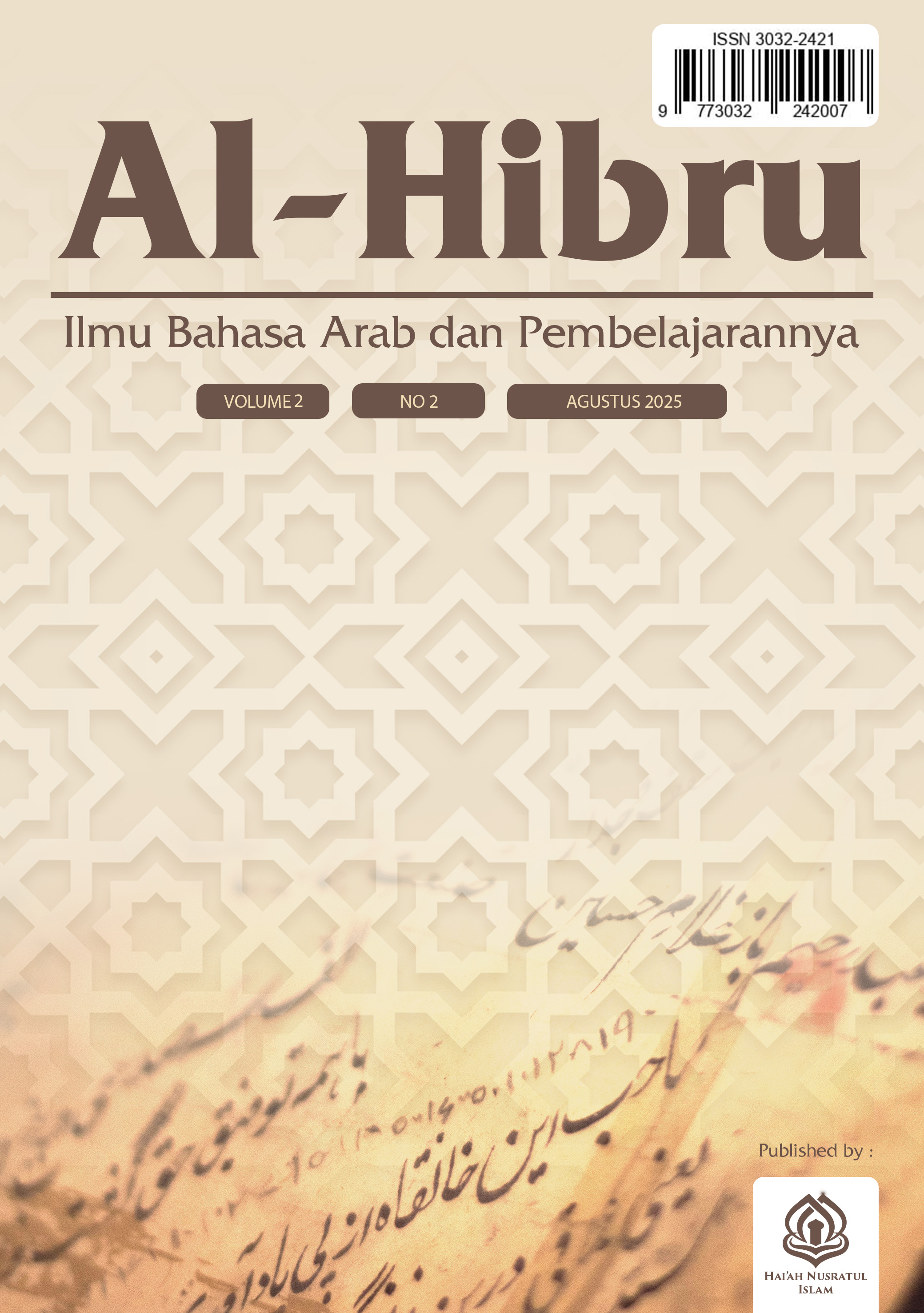ANALYSIS OF AL-KINAYAH IN SURAH AL-ZALZALAH: Study of Figurative Rhetoric in Perspective Dirasah Balaghiyyah
DOI:
https://doi.org/10.59548/hbr.v2i2.412Keywords:
Kinayah, Surah Al-Zalzalah, BalaghiyyahAbstract
This study aims to identify and analyze the use of al-kinayah (figurative expressions) in Surah Al-Zalzalah and to reveal its aesthetic value and semantic function in conveying eschatological messages. The method used is qualitative research with a balaghah analysis approach (Arabic rhetoric) that focuses on the aspect of al-bayan, especially al-kinayah. Data collection was carried out through literature studies and content analysis of the text of Surah Al-Zalzalah. The results of the study show that there are five forms of al-kinayah in this surah that have different semantic functions, namely: (1) al-kinayah about the shaking of the earth as a sign of the apocalypse, (2) al-kinayah about the earth releasing its burdens, (3) al-kinayah about human confusion, (4) al-kinayah about humans in various conditions, and (5) al-kinayah about actions as small as particles. This study concludes that the use of al-kinayah in Surah Al-Zalzalah plays an important role in increasing the effectiveness of message delivery and textual aesthetic value.
References
Abdul Raof, H. (2006). Arabic Rhetoric (Pertama). Routledge. https://doi.org/10.4324/9780203965399
Al‐Hasyimi, A. (2007). Jawāhir al‑Balāgha fī al‑Maʿānī wa al‑Bayān wa al‑Badīʿ. Dār al‑Kutub al‑ʿIlmiyyah.
Al‐Jurjānī, ʿAbd al‑Qāhir. (1984). Dalāʾil al‑Iʿjāz. Maktabah al‑Khānǧī.
Al‐Qazwinī, M. ʿAbd al‑Raḥmān. (1998). Al‑Idḥāʾ fī ʻUlūm al‑Balāgha. Dār Iḥyāʼ al‑ʿUlūm.
Al‐Qurṭubī, M. bin A. (2006). Al‑Jāmiʿ li Aḥkām al‑Qurʾān (Tafsīr al‑Qurṭubī). Muʾassasah al‑Risālah.
Al‑Zamakhsharī, M. bin ʿUmar. (2009). Al‑Kaššāf ʿan Ḥaqāʾiq Ghawāmiḍ al‑Tanzīl. Dār al‑Kitāb al‑ʿArabī.
Basid, A., & Faizin, N. (2021). Kinayah Language Style In Al- Quran And Hadith Perspective. International Seminar on Language, Education and Culture, 154–158.
Haq, A. Y. N., & Sipahutar, A. Y. (2024). Analisis Redaksi Kinayah dalam Al- Qur ’ an Surah Thaha Ayat 110. Al-Tarbiyah: Jurnal Ilmu Pendidikan Islam, 2(4), 19–26. https://doi.org/https://doi.org/10.59059/al-tarbiyah.v2i4.1386
Ibnu Kathīr, I. bin ʿUmar. (1999). Tafsīr al‑Qurʾān al‑ʿAẓīm. Dār Ṭayyibah.
Khalilah, Z., & Siagian, S. S. (2025). Analysis Of Metaphor And Simile In The Poem Al- I’ Tiraf By Abu Nawas. Eduslamic: Jurnal Pendidikan Islam Dan Keagamaan, 2(2). https://doi.org/10.59548/jed.v2i2.319
Muluk, T. (2020). Kinayah wa Ta’ridl al-Qur’an (Kajian Pemikiran Imam al-Zarkasi). An-Nur Jurnal Studi Islam, X(1), 1–24.
Muzakki, A. (2019). Stilistika al‑Qurʾān. UIN Maulana Malik Ibrahim Press.
Nurkhalis, A. (2020). Analisis Balaghah Dalam Juz Amma. Journal of Tianjin University Science and Technology, 54(6), 348–359.
Nurwahdi. (2017). Redaksi Kinayah Dalam Al-Quran. Jurnal Ulunnuha, 6(1), 63–79.
Sagala, R. (2016). Balaghah.
Saiffuddin. (2018). Uslub Kinayah Dalam Al-Qur’an : Kajian Balaghah. Universitas Islam Negeri Sultan Syarif Kasim Riau.
Shihab, Q. (2002). Tafsir Al- Misbah. Lentera Hati.
Syam, I. K., Komarudin, E., & Taufiq, W. (2022). Types and Purposes of Kinayah in the Qur ’ an. Mashadiruna: Jurnal Ilmu Al-Qur’an Dan Tafsir, 1(1), 3–8. https://doi.org/10.15575/mjiat.v1i1.19394
Trisnawan, P. (2019). Analisis Makna Kinayah Dalam Al-Qur’an Juz 30. Institut Agama Islam Negeri Palu.
Downloads
Published
How to Cite
Issue
Section
License
Copyright (c) 2025 Zikrani Khalilah, Zellyka Siti Rahmadani

This work is licensed under a Creative Commons Attribution 4.0 International License.
- Share — copy and redistribute the material in any medium or format for any purpose, even commercially.
- Adapt — remix, transform, and build upon the material for any purpose, even commercially.
- The licensor cannot revoke these freedoms as long as you follow the license terms.
Under the following terms:
- Attribution — You must give appropriate credit , provide a link to the license, and indicate if changes were made . You may do so in any reasonable manner, but not in any way that suggests the licensor endorses you or your use.
- No additional restrictions — You may not apply legal terms or technological measures that legally restrict others from doing anything the license permits.
Notices:
You do not have to comply with the license for elements of the material in the public domain or where your use is permitted by an applicable exception or limitation .
No warranties are given. The license may not give you all of the permissions necessary for your intended use. For example, other rights such as publicity, privacy, or moral rights may limit how you use the material.













 Based on a work at
Based on a work at 